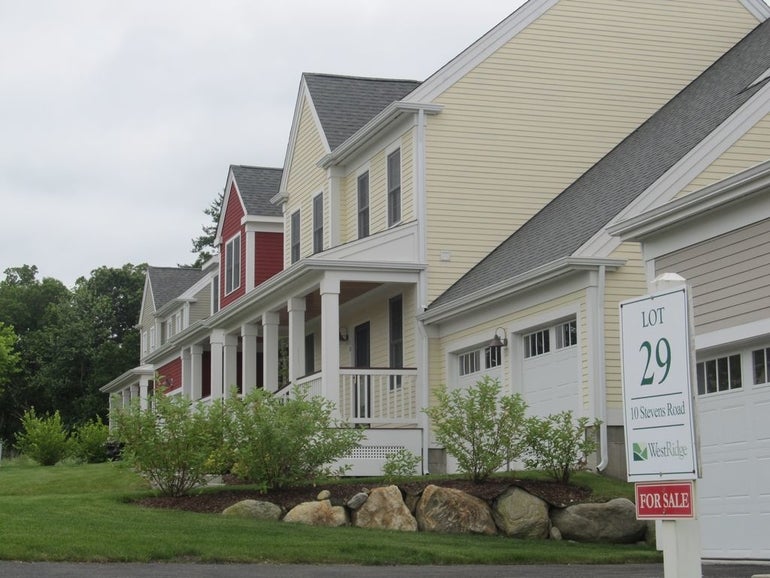Architects Focus On Aging Population
 Matt Pilon
These homes at WestRidge in Hudson are among a number of 55+ communities built in MetroWest over the past decade.
Matt Pilon
These homes at WestRidge in Hudson are among a number of 55+ communities built in MetroWest over the past decade.
In Westborough, a developer was permitted last month to build 124 apartments for people aged 62 and over, as well as the disabled.
Such developments have increasingly cropped up in the region over the past decade as the Baby Boomer generation ages. Westborough even passed a overlay district specifically for senior housing and assisted living facilities several years ago.
As towns deal with the housing needs of their aging population, architects are also delving deep into what the aging population means for their industry.
As a society, we've discussed how the estimated 78 million aging boomers will impact the healthcare system, social security benefits, the workforce, and the economy.
But what about the structures and buildings we live in, work in, shop at, or otherwise frequent on a daily basis?
Experts say architecture is the next logical stress point as Baby Boomers – or those born between 1946 and 1964 – crest into their silver-haired years, particularly here in Massachusetts, where nearly 20 percent of the population is age 60 and over, according to the U.S. Census Bureau.
"It will have a massive impact on how we look at housing," said Rep. Chris Walsh, D-Framingham, who is also an architect. "Even more than housing, [it will change] how we look at zoning."
Up until now, he and others note, the concept of designing housing for an aging population has been looked at only superficially in the United States.
But going forward, "the demographic realities are going to make it perfectly clear that it simply cannot be ignored, and there needs to be a design response," said Valerie Fletcher, executive director of the Boston-based Institute for Human Centered Design.
And projections from the U.S. Bureau of Labor Statistics seem to indicate that the response will come: Employment of architects is projected to grow 24 percent from 2010 to 2020 – faster than the average for all occupations.
As noted on the BLS website, "current demographic trends will result in a greater need for architects."
Beyond Aging
The overarching design sensibility that experts expect will take shape over the next several years goes beyond just aging. A school of thought known by many titles – from "universal design," to "design for all" to "human-centered design" – is a concept that stresses accessibility and comfort for all people, whether young, old, in peak physical shape, or physically or mentally disabled.
But particularly for the boomer set, a study from Britain highlights some of the design hallmarks that cater to aging workers related to sight, hearing, mobility and ergonomic comfort.
Because changes occur in visual acuity, depth perception and peripheral vision as we age, glare from windows and computers can impact sight, according to the study "Welcoming Workplace – Designing Office Space for an Aging Workforce in the 21st Century Knowledge Economy."
Therefore, the study suggests, workplaces could consider implementing systems that limit glare, provide natural light, and allow for ambient lighting that can be controlled on a zone-by-zone basis throughout the day.
Likewise, because hearing diminishes as we get on in years, the study suggests controlling sound transmission, and diminishing background noise by separating machines such as printers and photocopiers from quieter work areas; reducing reverberation and sound reflection with acoustic ceilings, carpeted floors and sound-absorbing panels or barriers; designating quiet work zones; and creating alternative spaces, such as small meeting rooms for private conversations or telephone calls.
As for accommodating the aging body: The study suggests height-adjustable furniture and ergonomic office chairs, as well as layouts that are easy to navigate, and have effective signage, color coding, and land-marking.
"When we get lost, we tend to blame ourselves," agreed Fletcher, whose nonprofit, educational organization works in the public and private sector in the U.S. and globally. "But it's actually a failure of design."
Similarly, she said, it's about organizing spaces so people can pull away from a group and get a sense of control if they're dealing with mental disabilities.
There's also the issue of addressing indoor air quality to meet the needs of different people, an overlap that exists between universal design and green design, she said.
Ultimately, universal design is "what makes for the best performance for everyone," she said. "It means flexibility in the workplace."
And that's true in the home, as well. According to a presentation at the American Institute of Architects' 2012 National Convention and Design Exposition entitled "Welcome Home," the aging population in the 21st century will demand design concepts such as main-floor living, step-less entries and no-step access between rooms, non-slip flooring, five-foot turning radius in rooms, and more daylight or special lighting. Meanwhile, there will be more of a need for communities with plaza-style developments combining housing, shopping and serving businesses, and that don't require a car, according to the presentation.
Societal Factors At Play
Ultimately, Walsh, like many others, thinks universal design will take more than a change in design. The shift will have social, legal, transportation and zoning components, as well, he said, and will inevitably impact everyone, as current systems will have to change and new ones will have to be put in place.
"It's really a rethinking of the pattern that's going to be important," he said. "As seniors are living longer and staying healthier longer, they're going to pretty much demand that that pattern changes."
Walsh, who also serves as president of the Central Massachusetts chapter of the American Institute of Architects, noted that the lack of change in that pattern to this point has been largely due to the longstanding societal structure.
The era following World War II saw the rise of the "nuclear family," and the movement of different generations into separate households, he said, which was later emphasized by the implementation of zoning laws in the 1950s.
That makes the boomers "the first real wave of people who are having to deal with this."
And change "starts with society actually thinking about this," he said.
Fletcher, for her part, stressed that there's a big difference between universal design and policies such as the Americans with Disabilities Act and the Fair Housing Act.
Fighting the perception that the two are synonymous has been an "attitudinal barrier" constraining the growth of universal design concepts, she wrote in a 2011 paper, "Evolution and Trends of Inclusive Design in the USA." Another barrier is the cultural fixation on youth, she wrote.
As of 2011, there were courses in universal design in only a small number of the country's design schools, according to the paper, a fact that spurred Fletcher's organization to partner with Boston Architectural College to create 30 graduate level distance learning courses that will be accredited in both the U.S. and Britain.
All told, she said, "this is an attractive, challenging opportunity for designers to create world that just makes more sense."
Walsh, meanwhile, said he thinks the concept will have much more of an impact on the architectural profession over the next 10 to 15 years, as Boomers and those after them continue to age.
Walsh, meanwhile, said he thinks the concept will have much more of an impact on the architectural profession over the next 10 to 15 years, as Boomers and those after them continue to age.
"We have been thinking about this for quite a while," he said. "It's a huge opportunity for architects, quite honestly."









0 Comments